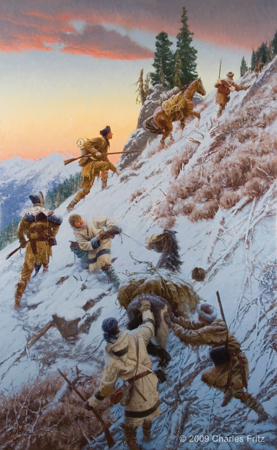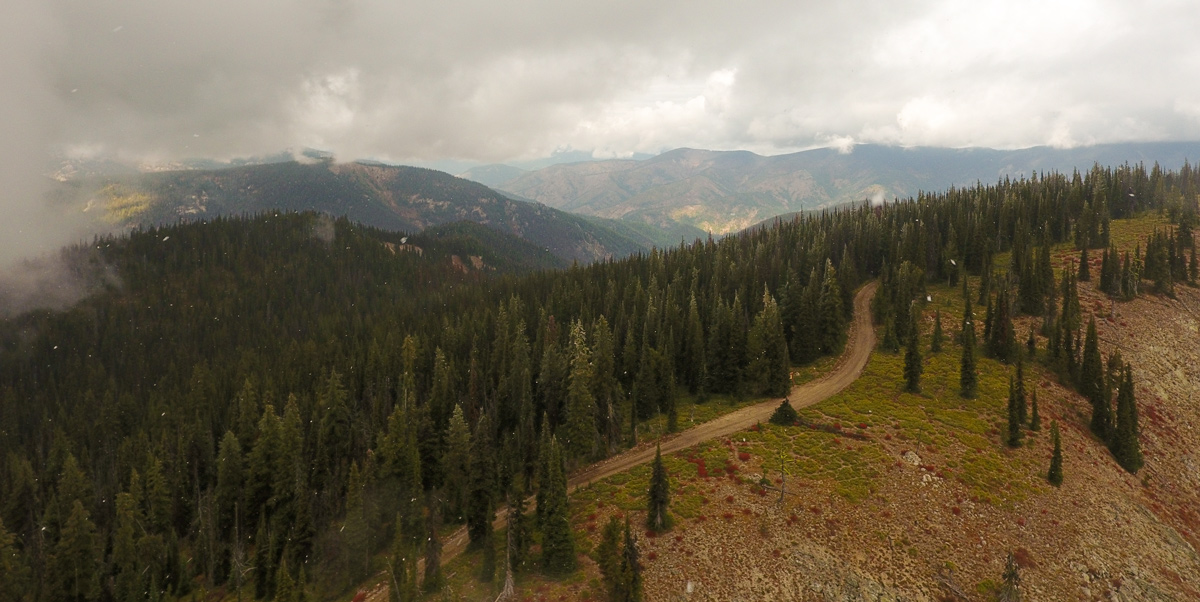On the Northern Nez Perce Trail, overnight snow makes for a miserable day in the “most terrible mountains”. Wet and cold as ever, Clark moves ahead to make warming fires in a lonesome cove. A colt is killed for dinner.
And Then It Started Snowing
by Yellowstone Public Radio[1]Originally aired weekdays by Yellowstone Public Radio during the Bicentennial observance of 2003-2006. Narrated by Hal Hansen. Scripts by Whit Hansen and Ed Jacobson. Produced by Leni Holliman. © … Continue reading
Crossing the Most Terrible Mountains We Ever Beheld
58″ x 36″ oil on canvas
© 2009 by Charles Fritz. Used by permission.
Early Morning Snow
began to Snow about 3 hours before Day and Continud. all day the Snow in The morning 4 Inches deep on The old Snow, and by night we found it from 6 to 8 Inches deep
—William Clark
Most Terrible Mountains Ever
proceeded over the most terrible mountains I ever beheld. It continued snowing until 3 o’clock P. M. when we halted, took some more [portable] soup, and went on
—Patrick Gass
Wet and Cold as Ever
a thickly timbered Countrey of 8 different kinds of pine, which are So covered with Snow, that in passing thro them we are continually covered with Snow, I have been wet and as cold in every part as I ever was in my life, indeed I was at one time fearfull my feet would freeze in the thin mockersons which I wore
—William Clark
Snow Storm above Lonesome Cove
© 4 October 2018 by Kristopher K. Townsend. Permission to use granted under the Creative Commons Attribution-Share Alike 4.0 International license.
Above: the Lolo Motorway follows the ridge line at Indian Post Office. The camera is facing easterly and Lonesome Cove Camp is down in the dark draw on the left. See also Naming the Lolo.
A Lonesome Cove
I took one man and proceeded on as fast as I could . . . . and built fires for the party agains their arrival which was at Dusk verry cold and much fatigued we Encamped at this Branch in a thickly timbered bottom which was Scercely large enough for us to lie leavil, men all wet cold and hungary. Killed a Second Colt which we all Suped hartily on and thought it fine meat.
—William Clarkwe descended the mountain down in a lonesome cove on a creek where we Camped
—Joseph Whitehouse
Weather Diary
Weather at rise
Wind at rise
Weather at 4 P.M. Wind at 4 P.M. cloudy after snow S W fair S W. Snow commenced about 4 oClock A. M. and continued untill night. it is about 7 inches deep. ice one inch thick. [Clark adds:] the Snow fell on the old Snow 4 inches deep last night.
—Meriwether Lewis and William Clark[2]To assist the reader, the editor of this web page has omitted the date column and spelled out some abbreviations.
Notes
| ↑1 | Originally aired weekdays by Yellowstone Public Radio during the Bicentennial observance of 2003-2006. Narrated by Hal Hansen. Scripts by Whit Hansen and Ed Jacobson. Produced by Leni Holliman. © 2003 by Yellowstone Public Radio. |
|---|---|
| ↑2 | To assist the reader, the editor of this web page has omitted the date column and spelled out some abbreviations. |
Experience the Lewis and Clark Trail
The Lewis and Clark Trail Experience—our sister site at lewisandclark.travel—connects the world to people and places on the Lewis and Clark Trail.
Discover More
- The Lewis and Clark Expedition: Day by Day by Gary E. Moulton (University of Nebraska Press, 2018). The story in prose, 14 May 1804–23 September 1806.
- The Lewis and Clark Journals: An American Epic of Discovery (abridged) by Gary E. Moulton (University of Nebraska Press, 2003). Selected journal excerpts, 14 May 1804–23 September 1806.
- The Lewis and Clark Journals. by Gary E. Moulton (University of Nebraska Press, 1983–2001). The complete story in 13 volumes.



